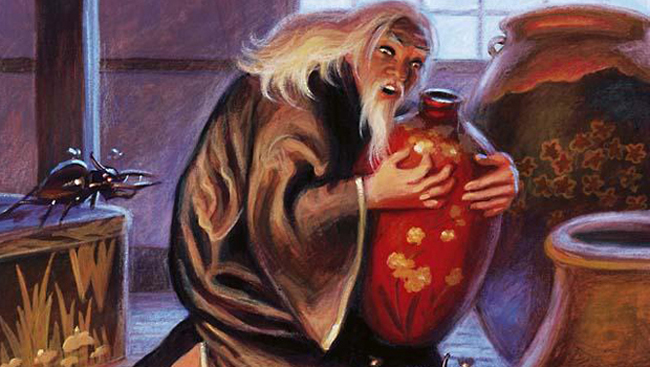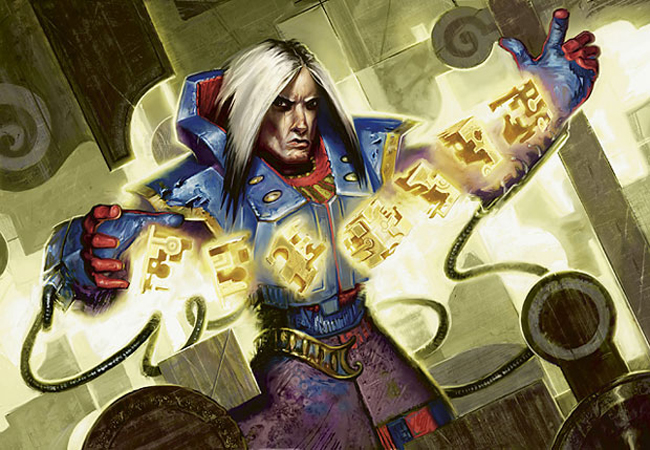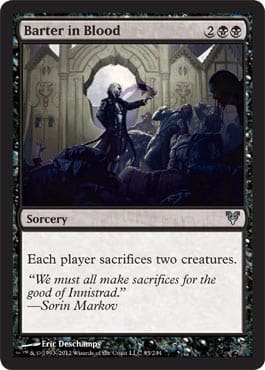This past weekend, we in the Los Angeles area had a little event we refer to colloquially as “Grand Prix Anaheim.” Attending a Grand Prix is always a fantastic experience: You get world-class competition, famous spellslingers, awesome artists, a ton of different stores, and more side events than you can count (unless you listen to the judge announcing Draft number two hundred and twelve).
And that’s not to mention all of the unofficial perks! Reconnect with friends from far-flung reaches of the globe, jump into as many Cube Drafts as you can handle, play some pickup Commander, and really, just about anything Magic-related is fair game. I even had the privilege of hanging out with mothership columnist and GatheringMagic content manager Adam Styborski on Friday and Sunday!
Before I get any further into this article, I want to thank Glenn and Jody Godard, the entire judge staff, and everyone else who helped put together the event for a memorable and smoothly run Grand Prix. I also want to congratulate Marc Lalague on taking the whole thing down. Marc’s a local Californian ringer and a great guy, and it’s fantastic to finally see him take the spotlight.
Prep Work
Now onto some things that might benefit you as a Magic player. On Monday, Darwin Kastle wrote about his preparation for the main event, and while I’m not a Pro Tour Hall of Famer, after reading his article, I still thought I had something to offer about preparation, so here I am, writing this article for you.
I feel that Darwin glazed over an incredibly important point: the fact that Grand Prix: Anaheim was a Block Constructed event meant that it was a one-shot tournament. A lot of people have a favorite deck that they’ll play for an entire Standard season, and there’s a lot of disagreement among the best players in the world as to whether being experienced with your deck is more important than having the right deck for an event.
The disagreement naturally stems from the fact that the answer is different for different people. Some players have a gift for spotting card interactions and can thus figure out a deck on the fly; others need to learn their decks inside and out, but can then play those decks without making many mistakes. But unless you’ve been grinding Block queues on Magic Online, there was no way that you had a deck you were experienced with going into the back-to-back Pro Tour: Avacyn Restored and Grand Prix: Anaheim. You simply had to pick your deck for the event itself.

Choice of Damnations by Tim Hildebrandt
Things were a lot easier for the Grand Prix than for the Pro Tour, and not just in terms of competition. Going into Barcelona, nobody knew about the post-Avacyn Restored format, but looking to Disneyland, we had a defined metagame: the Pro Tour’s Top 8.
But I didn’t want to wait until the last minute to start thinking about the format. If I could find a good deck that wasn’t spoiled in Barcelona and I could become comfortable with it, that would give me a huge leg up on the competition come crunch time. Instead of starting to prepare after the Pro Tour, I began when the complete spoiler for Avacyn Restored was released. I looked for powerful strategies in Block, and the immediately obvious ones were various aggro builds and, of course, Unburial Ritesing a Griselbrand on the fourth turn.
Zombie aggro seemed okay, but Kessig Malcontents seemed insane, so I started with Boros Humans:
"Boros Humans"
- Creatures (28)
- 2 Cloistered Youth
- 2 Doomed Traveler
- 2 Fiend Hunter
- 4 Champion of the Parish
- 4 Kessig Malcontents
- 4 Loyal Cathar
- 4 Reckless Waif
- 3 Mikaeus, the Lunarch
- 3 Thalia, Guardian of Thraben
- Spells (8)
- 4 Brimstone Volley
- 4 Gather the Townsfolk
- Lands (24)
- 6 Mountain
- 7 Plains
- 3 Slayers' Stronghold
- 4 Cavern of Souls
- 4 Clifftop Retreat
It quickly became apparent that triggering Champion of the Parish a bunch of times was the best thing you could be doing, so I decided to try out Thatcher Revolt. It was strong with Champion, but really inconsistent, so I promptly cut Champion of the Parish . . . What?
"Boros Humans II"
- Creatures (29)
- 1 Riot Ringleader
- 4 Avacyn's Pilgrim
- 4 Champion of Lambholt
- 4 Hamlet Captain
- 4 Kessig Malcontents
- 4 Kruin Striker
- 4 Mayor of Avabruck
- 4 Reckless Waif
- Spells (7)
- 3 Brimstone Volley
- 4 Thatcher Revolt
- Lands (24)
- 7 Forest
- 7 Mountain
- 2 Kessig Wolf Run
- 4 Cavern of Souls
- 4 Evolving Wilds
This build had some sweet draws, but it was ultimately pretty hit or miss. Next, I tried to jam Gather the Townsfolk in, but it didn’t work at all with Cavern of Souls doing nothing to help cast the sorcery. Finally I tried a G/W Humans build to see if the Avacyn Restored cards were really worthwhile, but I never got far because it just seemed like a slower version of the Boros list with less reach.
With some preliminary aggro goldfishing out of the way, it was time to try for a broken combo deck:
"Broken Combo Deck"
- Creatures (8)
- 2 Avacyn, Angel of Hope
- 2 Gisela, Blade of Goldnight
- 4 Griselbrand
- Spells (26)
- 2 Burning Oil
- 3 Dangerous Wager
- 4 Forbidden Alchemy
- 2 Defy Death
- 3 Terminus
- 4 Faithless Looting
- 4 Pillar of Flame
- 4 Unburial Rites
- Lands (26)
- 1 Mountain
- 1 Swamp
- 2 Island
- 4 Plains
- 2 Shimmering Grotto
- 4 Clifftop Retreat
- 4 Desolate Lighthouse
- 4 Evolving Wilds
- 4 Sulfur Falls
This is perhaps not the most tuned list, and it didn’t take long to realize that Gisela is miles ahead of Avacyn as far as playability goes . . . or that the deck literally could not beat a Purify the Grave with Dissipate as the only available answer in the format.
That got me trying to find some sort of deck that could combo off with Unburial Rites without scooping to graveyard hate. Enter Angel of Glory's Rise:
"Angel Combo"
- Creatures (26)
- 1 Elite Inquisitor
- 2 Fiend Hunter
- 2 Mad Prophet
- 3 Angel of Glory's Rise
- 4 Champion of the Parish
- 4 Cloistered Youth
- 4 Doomed Traveler
- 4 Kessig Malcontents
- 2 Mikaeus, the Lunarch
- Spells (10)
- 3 Dangerous Wager
- 3 Unburial Rites
- 4 Faithless Looting
- Lands (24)
- 6 Mountain
- 8 Plains
- 2 Slayers' Stronghold
- 4 Cavern of Souls
- 4 Clifftop Retreat
Soon thereafter, my teammates and I began to discuss the format on our secret forum (read: e-mail). The first subject was this deck, one that three of us had brewed up independently. Five days later, Travis Woo posted this article.

Angelic Chorus by Jim Murray
A not-so-secret brew is about as far as we got before the Pro Tour, at which point the name of the game became beating the Top 8’s decks.
Attacking the Metagame
The first thing that occurred to me on the road home from yet another unsuccessful Pro Tour Qualifier (PTQ) was that every deck with the exception of Hayne’s Hallelujah! was soft to Terminus. That in turn put the one deck running Terminus in a very good position, and we started talking about miracles. We couldn’t find a good reason not to substitute Clifftop Retreat and Sulfur Falls for some basic lands to have access to more sweepers alongside Desolate Lighthouse, and it seems that the ChannelFireball crew came to the same conclusion, as evidenced by Erich Froehlich’s Top 8 deck at the Grand Prix in question. Unfortunately, while I like to pretend that cost isn’t an issue, we simply didn’t have enough copies of the deck’s numerous mythic rares to spread around, and the additional $300 per person just didn’t seem reasonable for cards we might only use in a single tournament.
It was time to find another Terminus deck, and looking back over my initial sweep through the format, I ran across the previously mentioned reanimator list and decided to start again from scratch:
"Reanimator from Scratch"
- Creatures (7)
- 3 Gisela, Blade of Goldnight
- 4 Griselbrand
- Spells (28)
- 1 Geistflame
- 4 Dangerous Wager
- 1 Blasphemous Act
- 2 Defy Death
- 4 Faithless Looting
- 4 Pillar of Flame
- 4 Rolling Temblor
- 4 Terminus
- 4 Unburial Rites
- Lands (25)
- 1 Swamp
- 11 Mountain
- 5 Plains
- 1 Isolated Chapel
- 3 Evolving Wilds
- 4 Clifftop Retreat
A couple of iterations later, it was clear that there was no reasonable sideboard plan against real hate, and I needed a less focused reanimator deck, but control didn’t really seem to be workable. My exploration halted as I was assaulted by the scourge known as “midterms.”
Then, on a rare study break, I watched an episode of Magic TV about the Block format, in which Luis Scott-Vargas made an off-hand comment about a reanimator build full of removal. A light bulb went off, the gears started turning, and I soon arrived at this:
"Reanimator with Removal"
- Creatures (7)
- 3 Gisela, Blade of Goldnight
- 4 Griselbrand
- Planeswalkers (4)
- 4 Liliana of the Veil
- Spells (24)
- 3 Dangerous Wager
- 4 Tragic Slip
- 1 Blasphemous Act
- 1 Devil's Play
- 1 Pillar of Flame
- 2 Barter in Blood
- 4 Faithless Looting
- 4 Sever the Bloodline
- 4 Unburial Rites
- Lands (25)
- 1 Plains
- 5 Mountain
- 7 Swamp
- 4 Clifftop Retreat
- 4 Evolving Wilds
- 4 Isolated Chapel
- Sideboard (15)
- 4 Markov Blademaster
- 4 Bloodline Keeper
- 3 Olivia Voldaren
- 3 Demonic Rising
- 1 Bloodgift Demon
Every deck except Hallelujah! was infested with creatures, and while less advantageous than wrathing them away, removing the threats one at a time allowed for a lot more flexibility. I knew that I’d face hate post-board, so I started thinking about what else I could do with a ton of removal, and the answer seemed to be “play Jund.” I only was able to test one game before midterm preparation once more claimed my time, but after hard-casting three fatties in that game, I decided to cut back on the reanimation package for more removal.
The Home Stretch
On Thursday evening, I heard word on Twitter that LSV was playing a similar deck against Brian Kibler on stream, so I tuned in to watch. The only new thing I noticed was Sorin, Lord of Innistrad (which I can’t believe I forgot about), but I was gratified to see that one of the world’s best seemed to have come to the same control shell, and he even cast a Bloodline Keeper in Game 2! A couple more untested tweaks later, and I had a list for Saturday morning:
"Our Market Research Shows That Players Like Really Long Deck Names So We Made This Deck To Have The Absolute Longest Deck Name Ever Elemental (Just call it OMRSTPLRLDNSWMTDTHTALDNEE for short.)"
- Creatures (5)
- 1 Gisela, Blade of Goldnight
- 4 Griselbrand
- Planeswalkers (6)
- 2 Sorin, Lord of Innistrad
- 4 Liliana of the Veil
- Spells (24)
- 1 Victim of Night
- 4 Tragic Slip
- 1 Devil's Play
- 2 Barter in Blood
- 2 Pillar of Flame
- 2 Rolling Temblor
- 3 Sever the Bloodline
- 4 Faithless Looting
- 4 Unburial Rites
- 1 Dead Weight
- Lands (25)
- 1 Plains
- 4 Mountain
- 8 Swamp
- 4 Clifftop Retreat
- 4 Evolving Wilds
- 4 Isolated Chapel
- Sideboard (15)
- 4 Bloodline Keeper
- 4 Olivia Voldaren
- 3 Demonic Rising
- 1 Vessel of Endless Rest
- 3 Purify the Grave
In total, I’d played six games with the deck before sitting down for my first match of the tournament after a Round 1 bye, and I can’t emphasize enough that this is not what you want to do. Playing a deck cold is bad enough as it is: You’ll make stupid mistakes and misevaluate your role in the game constantly.
But playing an untested deck means that you won’t even have the right tools for the job assuming you can figure out what to do. Don’t get me wrong; I’m not saying the deck is bad. In fact, I think B/R reanimator control may have been the correct choice for the tournament, but not this list.
The removal I selected was too mana-intensive to compete with Boros (the matchup against which I earned two of my three losses), and the mana base wasn’t optimized to make Liliana of the Veil and Barter in Blood active as consistently as they needed to be for the Bant Spirits matchup.
The particulars of my matchups are more or less irrelevant since there aren’t going to be any more major Innistrad Block Constructed events, though I’ll be happy to share in the comments if that’s what you want. More important is what both you and I can take away from the experience and apply to future events.
Testing 1, 2, 3
I know I’ve been harping on this, but it’s important. In that failed PTQ I mentioned driving back from, I went 5–2 playing a Wolf Run Ramp. I don’t play Standard, and as with the Grand Prix, I think I’d played about five games with the deck going into the tournament. If I’d played every matchup and built a real sideboard instead of theory-crafting one in the car, do you think I could have Top 8’d? I certainly do.
The same goes for all of the qualifiers during Modern season in which I piloted Melira-Pod while figuring out matchups on the fly. My results improved (marginally) over the course of the season, so what if I’d started out with as much experience as I had by the end?

Time Stretch by Matt Cavotta
Saying, “You should playtest,” is easy, but actually doing it is hard. None of us can commit every waking moment to Magic, so making time to playtest necessarily requires passing up a Cube Draft or an FNM. You don’t need to do that, but you should be aware that you’re handicapping yourself when you don’t. There’s a reason the top pros head to Pro Tour sites a week in advance and spend twelve hours a day playing Magic: It works.
Testing with Intent
But now, you’ve got me. You did test for your last PTQ. You spent three nights last week running games, and you still ended up 4–3. So, it wasn’t worthwhile after all. Unfortunately, while just running a lot of games will help, it won’t be enough. You need to test for something.
What is important in a given matchup? Where does your deck stumble repeatedly? What spells have enough impact to make action-light hands keepable? Can you win in the late game or do you have to mulligan anything slow? Does your sideboard plan successfully work around not just your opponents’ decks but also their sideboard plans?
Breaking Point
I didn’t have answers to most of those questions, but going 6–3 to miss Day 2 isn’t all that bad with an untested deck. If I’d had three byes going in as I did at Grand Prix San Diego, I probably would have made Day 2 despite the deck’s deficiencies.
That’s because running a million removal spells really was the answer to the format. It’s very rare for somebody to actually break a Block format because the card pool is too small for most of the worlds’ best deck builders to miss something powerful. I’m not trying to claim that I broke the format, but I do think a better structured All-Removal Reanimator list could easily have positive matchups everywhere except against Hallelujah! and Boros, and I wish I’d come to such a list.
You probably won’t find this sort of deck browsing through the format for synergies; you need to find a through line in the metagame—something that a whole host of decks are weak against—and exploit it. I don’t have a magic formula for that either, but if you try to find good strategies against one deck and then see how they play out in other matchups, you might just find what you’re looking for.
That’s more than enough of me spouting deck design theory for one week. In fact, it’s probably enough to last you quite a few weeks, so next Wednesday, you can expect something a little bit further from the competitive end of the spectrum. Until then, I hope you found some of this helpful, and I look forward to losing the bubble round to your sweet brew in the next PTQ we attend together.



























